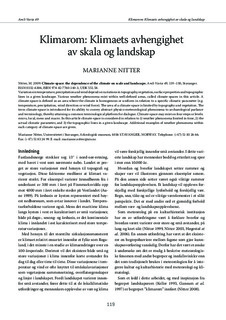| dc.contributor.author | Nitter, Marianne | |
| dc.date.accessioned | 2012-11-15T13:24:05Z | |
| dc.date.available | 2012-11-15T13:24:05Z | |
| dc.date.issued | 2009 | |
| dc.identifier.citation | Nitter, M. (2009) Klimarom : klimaets avhengighet av skala og landskap. In Nitter, M. og Pedersen, E.S (red.) Tverrfaglige perspektiver. Stavanger : Arkeologisk museum i Stavanger | no_NO |
| dc.identifier.uri | http://hdl.handle.net/11250/181456 | |
| dc.description.abstract | Variations in temperature, precipitation and wind depend on variations in topography, vegetation, surface properties and topographic
lines in a given landscape. Various weather phenomena exist within well-defined areas, called climate-spaces in this article. A
climate-space is defined as an area where the climate is homogenous or uniform in relation to a specific climatic parameter (e.g.
temperature, precipitation, wind direction or wind force). The area of a climate-space is limited by topography and vegetation. The
term climate-space is introduced for its ability to convey abstract physico-meteorological phenomena to archaeological parlance
and terminology, thereby attaining a common terminological platform for dialogue. Climate-space may exist on four steps or levels:
micro, local, meso and macro. In this article climate-space is considered in relation to 1) weather phenomena limited in time, 2) the
actual climatic parameter, and 3) the topographic lines in a given landscape. Additional examples of weather phenomena within
each category of climate-space are given. | no_NO |
| dc.language.iso | nob | no_NO |
| dc.publisher | Arkeologisk Museum i Stavanger | no_NO |
| dc.relation.ispartofseries | AmS-Varia;49 | |
| dc.subject | arkeologi | no_NO |
| dc.subject | klima | no_NO |
| dc.subject | vær | no_NO |
| dc.title | Klimarom : klimaets avhengighet av skala og landskap | no_NO |
| dc.type | Chapter | no_NO |
| dc.type | Peer reviewed | no_NO |
| dc.subject.nsi | VDP::Humanities: 000::Archeology: 090::Nordic archeology: 091 | no_NO |
